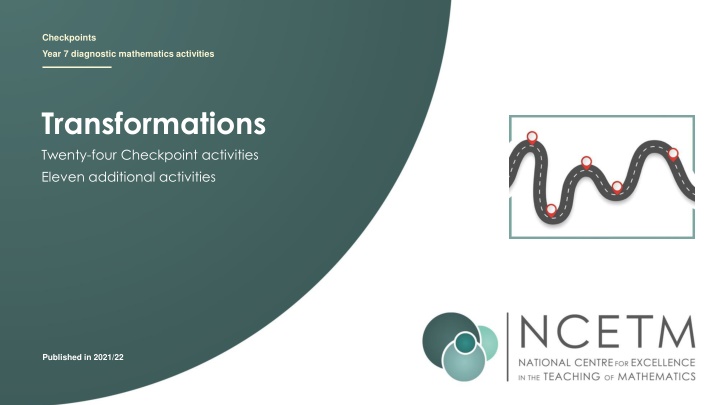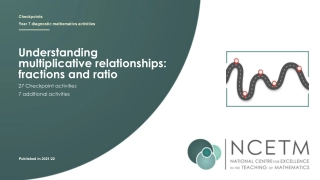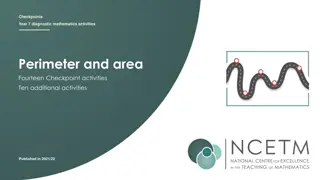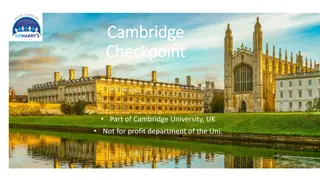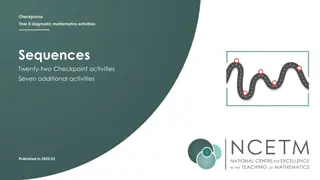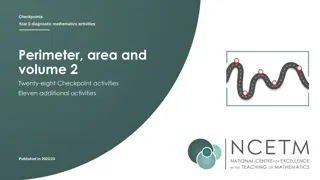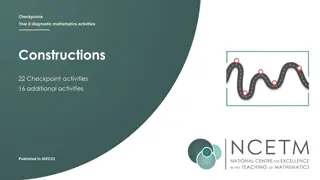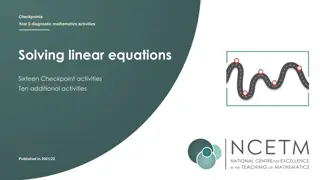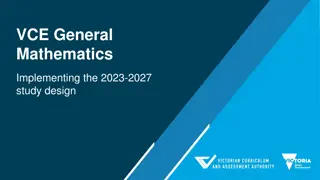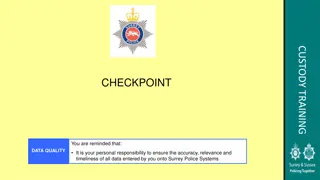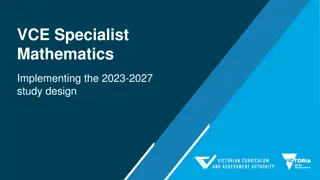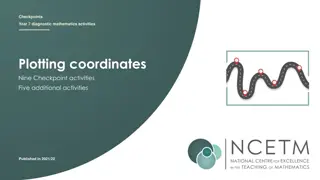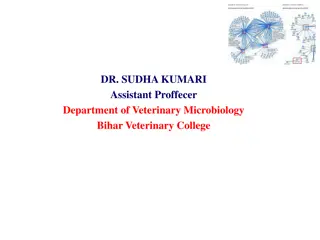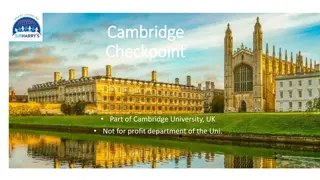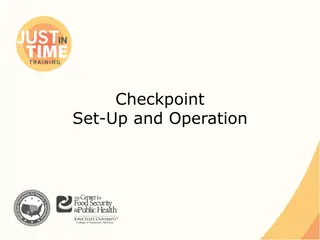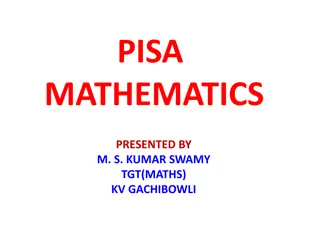Mathematics Transformation Checkpoint Activities for Year 7 Students
Engage Year 7 students with 24 Checkpoint and 11 additional activities focused on transformations, including tessellations and pentominoes. Explore concepts such as triangles and codes to enhance mathematical understanding. Ideal for a diagnostic assessment to identify areas of strengths and areas needing improvement. Published in 2021/22.
Download Presentation

Please find below an Image/Link to download the presentation.
The content on the website is provided AS IS for your information and personal use only. It may not be sold, licensed, or shared on other websites without obtaining consent from the author.If you encounter any issues during the download, it is possible that the publisher has removed the file from their server.
You are allowed to download the files provided on this website for personal or commercial use, subject to the condition that they are used lawfully. All files are the property of their respective owners.
The content on the website is provided AS IS for your information and personal use only. It may not be sold, licensed, or shared on other websites without obtaining consent from the author.
E N D
Presentation Transcript
Checkpoints Year 7 diagnostic mathematics activities Transformations Twenty-four Checkpoint activities Eleven additional activities Published in 2021/22
Checkpoints 18 Checkpoint Underpins Code 1: The same triangle? 2: Tess-ellation 3: Pentominoes 6.3.1 6.3.2 6.3.3 4: Computer graphics Congruence 5: Sticker book 6: Headphones 7: Sliding box 8: Two ants move *This three-digit code refers to the statement of knowledge, skills and understanding in the NCETM s Sample Key Stage 3 Curriculum Framework (see notes below for more information).
Checkpoints 916 Checkpoint Underpins Code 9: Counter rectangle 10: Spinning snails 11: McTwist 6.3.1 6.3.2 6.3.3 12: L-turn John Congruence 13: Hinges 14: Orcombe Point 15: Flag sort 16: Where s the line? *This three-digit code refers to the statement of knowledge, skills and understanding in the NCETM s Sample Key Stage 3 Curriculum Framework (see notes below for more information).
Checkpoints 1724 Checkpoint Underpins Code 17: Octagon 18: Counters 6.3.1 6.3.2 6.3.3 19: Tiles Congruence 20: Jagged reflection 21: Red kite 22: Flagging 23: Scaling up Similarity 6.3.4 24: Rectangles *This three-digit code refers to the statement of knowledge, skills and understanding in the NCETM s Sample Key Stage 3 Curriculum Framework (see notes below for more information).
Transformations assessed in Checkpoints/Additional activities 1 2 3 4 5 6 7 8 9 10 11 12 13 14 15 16 17 18 Translation Rotation Reflection Enlargement 19 20 21 22 23 24 A B C D E F G H I J K Translation Rotation Reflection Enlargement
Congruence Checkpoints 1 21
Checkpoint 1: The same triangle? a) Which of these triangles are the same? b) Are there any that you need to know more about before you can be certain? C A B D E G Shapes E and H are not the same as shape A. Which of E and H is most like shape A? Explain the reasons for your answer. H F
Checkpoint 2: Tess-ellation Tessa made this pattern by drawing around an L-shaped stencil. She started with the red shape, labelled 1. 1 a) Choose an L shape where she could have slid the stencil along the page. b) Choose an L shape where she could have flipped the stencil over. c) Choose an L shape where she could have turned/spun the stencil. Tessa adds another shape by both flipping and spinning the stencil. What might this shape look like? Could any of the possible shapes fit on this grid?
Checkpoint 2: Tess-elation (animated solutions to parts a-c) Tessa made this pattern by drawing around an L-shaped stencil. She started with the red shape, labelled 1. 1 a) Choose an L shape where she could have slid the stencil along the page. b) Choose an L shape where she could have flipped the stencil over. c) Choose an L shape where she could have turned/spun the stencil.
Checkpoint 2: Tess-elation (animated solutions to further thinking question) Tessa made this pattern by drawing around an L-shaped stencil. She started with the red shape, labelled 1. Tessa adds another shape by both flipping and spinning the stencil. What might this shape look like? Could any of the possible shapes fit on this grid? 1
Checkpoint 3: Pentominoes Pentominoes are arrangements of five squares. Jasmine starts to arrange her squares like this: a) Where could Jasmine place her final square? b) How many different possibilities are there? c) How many of the possibilities create different shapes? How would your answers be different if your four starting squares were arranged differently?
Checkpoint 3: Pentominoes (animated solutions) How many of these solutions are different shapes?
Checkpoint 4: Computer graphics Monisha is making a poster using a computer. She has four options for how she can rotate or flip images. You can see them on the menu to the right. She has the images below on her poster. For which of the four rotate or flip options would: a) The star look the same? b) The first sun look the same? c) The moon look the same? d) The second sun look the same? What two clicks might Monisha have used to change the moon image to look like this:
Checkpoint 5: Sticker book Oscar is helping his little sister Evie to stick some vehicle stickers in her sticker book. Evie places the stickers into the book so that they are all the right way up with their wheels on the road. Which vehicles will be facing in the same direction? B E C F A H D G Sketch your own vehicles in different orientations. Can you draw two vehicles that face the same way, even if they are not drawn the same way up?
Checkpoint 6: Headphones A phone shop takes a delivery of headphones. They are meant to fit in a case like the one on the right. The box splits and the headphones spill all over the floor. Which are for the right ear (R), and which are for the left (L)? L R One headphone is missing. Is it a left or a right headphone? Draw the missing headphone. Is there more than one way to do this?
Checkpoint 6: Headphones (animated solutions) L R R R R L R L L R L Missing headphone: L R
Checkpoint 7: Sliding box The red box is 15 cm by 20 cm. Richard slides the box over the floor. a) How would Richard slide the box so that it fits into rectangle A? b) How would he slide the box from its original position to fit into rectangle B? c) How would he slide it from its original position to fit into C then on to D and from there to E? Which is the greater distance moving the box to A and back, then to B and back, then C and back, and so on to E; or moving from A to B to C and so on to E?
Checkpoint 8: Two ants move y Two ants are on a coordinate grid. They can move only horizontally or vertically, along the grid lines. Starting from the positions that they are in now, how could they each move so that: a) They swap places? b) They both end up at (0, 0)? c) They end up meeting halfway between their starting points? d) They end up closer to Ant s starting point than Dec s? Ant x Dec Both ants move five units horizontally and two units vertically. What is the closest they could now be? What is the furthest apart they could now be?
Checkpoint 9: Counter rectangle Some counters were arranged to make a rectangle. The blue counter (A) has been moved and stuck down. Describe how each of the other counters needs to move so that the same rectangle is created again. What do you notice? A D C B Without moving the blue (A) or green (B) counter from where they are in this image, how would you move the red (C) and yellow (D) counters to make a square?
Checkpoint 10: Spinning snails Picture A shows two snails sitting on a wheel. The wheel is rotated a quarter turn. Picture B shows the new position of the snails (with the faded images showing their original positions). Which of the following are true? a) Both snails moved clockwise. b) Both snails moved downwards. c) Both snails moved the same distance. d) Both snails moved 90 . A B Another snail climbs onto the wheel. Three of the above statements are true for this new snail and the snail originally on the outside of the wheel. Where might the new snail be?
Checkpoint 11: McTwist A McTwist is a skateboarding move that involves one and a half full turns. Here are four positions that a skateboarder could be in during a spin. 1 2 3 4 a) Which two could be a skateboarder before and after a McTwist? How do you know? What angle has the skateboarder turned through to complete a McTwist? What other angles could the skateboarder have turned through to end up in the same position? b) c) Skateboarders can also flip upside down. Jenny claims to have completed a 900 flip. Why must she be wrong?
Checkpoint 12: L-turn John John has two L-shaped tiles. He turns them and sticks them together to make different shapes. Do any of John s shapes have symmetry? All these shapes are formed by turning or sliding the tiles. Is John able to make more symmetrical shapes if he can flip the tiles over, too?
Checkpoint 13: Hinges Billy is using the protractor on his tool bench to make a hinge. When the hinge is closed it looks like the picture on the right. He can open the hinge by turning one part anticlockwise. Below are three different positions for the hinge. C A B Billy says he has put the pictures in order from the smallest to the biggest angle. Do you agree? Why or why not? How could Billy have turned the hinge to move from A to B? How about B to C? What do you notice about your answers?
Checkpoint 14: Orcombe Point At Orcombe Point in Devon there s a compass on the ground. Richard stands in the centre of the compass. The tile on the right is directly in front of him. If he then turns around and faces the opposite direction, what angle is written on the tile in front of him now? Sarah stands in the centre of the compass with the tile on the right directly in front of her. She turns 90 . What angle might be on the tile in front of her?
Checkpoint 15: Flag sort No lines of symmetry Exactly one line of symmetry More than one line of symmetry Genna sorts some flags into the table according to their lines of symmetry. a) Is she correct? b) If she is not correct, which flags would you move and why? Dominican Republic Venezuela Iceland Puerto Rico Switzerland Belgium Vietnam Taiwan Nigeria How could you change the designs of the flags so that they are in the right place in the columns Genna originally chose?
Checkpoint 15: Flag sort (solutions) No lines of symmetry Exactly one line of symmetry More than one line of symmetry Puerto Rico Nigeria Venezuela Vietnam Dominican Republic Switzerland Iceland Taiwan Belgium
Checkpoint 16: Wheres the line? Complete each diagram so that the dotted line is a line of symmetry. c) d) b) a) Draw each shape and reflect it in a different mirror line to those given. Can you create a reflection that no one else has thought of?
Checkpoint 16: Wheres the line? (solutions) a) b) c) d)
Checkpoint 17: Octagon Which of these lines is a line of symmetry for this regular octagon? A This octagon has eight lines of symmetry. Is it always true that a regular polygon has the same number of lines of symmetry as it has sides? B CD E
Checkpoint 18: Counters A blue counter is placed 10 cm away from a vertical red line. Three more counters are added to make the corners of a quadrilateral. The vertical red line is a line of symmetry for this quadrilateral. Can the four counters make: a) A square? b) A rectangle? c) A 30 cm by 40 cm rectangle? d) A parallelogram? 10 cm If two other counters were used instead, could they make an isosceles triangle with the line of symmetry? Where would they go?
Checkpoint 18: Counters (solutions for part a) For part b, the green counter must be in the same position as in the first two images. The grey counters could be moved vertically but not horizontally. 20 cm 10 cm 10 cm 10 cm 10 cm 10 cm 10 cm 10 cm 10 cm 20 cm
Checkpoint 19: Tiles The vertical red line is a line of symmetry. Each tile has a length of 1 cm. a) How far apart are the two purple tiles, marked B? b) How far apart are the two orange tiles, marked E? c) Which two tiles are 6 cm apart? A A B C C D D The whole pattern is reflected in the green horizontal line. There will now be four green tiles (marked A). Do they form the corners of a square? How about the purple tiles (B)? The blue (D)? The orange (E)? E E
Checkpoint 20: Jagged reflection b) c) a) d) Which of these are reflections? How could you correct the images that are not? Draw your own reflections using the same starting shape. Can you draw a reflection nobody else has?
Checkpoint 20: Jagged reflection (solutions) b) Two possible solutions: c) Three possible solutions: d) Two possible solutions:
Checkpoint 21: Red kite The points (4, 0) and (0, 2) are marked. They are two of the four coordinates of a kite. Starting with these two coordinates: a) Choose two more coordinates to create a kite that has the x-axis as its line of symmetry. b) Choose different coordinates to create a kite with the same line of symmetry. Can they both change? c) Choose different coordinates to create a kite that has the y-axis as its line of symmetry. y x Move your kite from part a so that one of the points is on (1, 1). How many different ways are there to do this?
Similarity Checkpoints 21 24
Checkpoint 22: Flagging On the left is an image of the Japanese flag. The image is 4 cm by 6 cm. Jaya wants to make the image bigger. She stretches it by 2 cm. Jaya notices that the flag doesn t look quite right. a) What do you think has gone wrong? b) Jaya stretches the flag by 2 cm in the other direction. Is this correct now? Explain how you know. How should Jaya stretch the image so that it looks right again?
Checkpoint 23: Scaling up Which of these is a correct enlargement of the small blue triangle? How do you know? Samir draws another enlargement of the small blue triangle. One of the lengths is 12 cm. What could the other length be?
Checkpoint 24: Rectangles The small rectangle, A, is 2 cm by 3 cm. Caroline arranges six of these to make another rectangle. a) Is the large rectangle just a larger version of rectangle A? b) If it isn t, how is it different? If it is, how do you know? A Is it possible to arrange 10 of rectangle A so they they make a larger version of A? How about 12 of rectangle A? What s the smallest number of tiles you d need?
Additional activities Activities A K
Activity A: Pegboard This is a 4 4 pegboard. There is an elastic band around the bottom row. Caleb stretches the elastic band so that it stays around the bottom four pegs, but loops around one more peg to make a triangle. An example is shown in the picture on the right. a) How many triangles can he make? b) How many of the triangles are the same as each other? How many different triangles could Caleb make if he didn t need to keep the band around the bottom four pegs?
Activity B: More Tess-ellation Tessa made this pattern by drawing around an L-shaped stencil. She started with the red shape marked 1. Describe how she had to move her stencil to go from the red shape to: a) The light purple shape b) The light blue shape c) The dark green shape d) The dark purple shape. c) 1 a) d) b) Pick two shapes and describe the movement from one to the other. Are there any other pairs with exactly the same movement?
Activity C: More pentominoes Pentominoes are arrangements of five squares. Jake starts to arrange his squares like this: a) Where could Jake place his final two squares? b) How many different possibilities are there? c) How many of the possibilities create different shapes? How would your answers be different if your three starting squares were arranged differently?
Activity C: More pentominoes (solutions) How many of these solutions did you find? How many of these solutions are different shapes?
Activity D: More computer graphics Tina is making a poster on the computer. She uses this image of an arrow: She then changes the shape, so it looks like this: Below are the four tools that she chose from when she changed her shape: a) What tool might Tina have clicked? Is there more than one possible answer? b) Tina used exactly two steps to change her shape. What might they have been? Can you find a way for Tina to have changed her shape in exactly four clicks? How about five?
Activity E: Fewer headphones A phone shop takes a delivery of headphones. They are meant to fit in a case like the one on the right. The box splits and the headphones spill all over the floor. Which headphones are for the right ear, and which are for the left? L R Draw the missing headphone. Is there more than one way to do this?
Activity F: Dinner date Sakthy and Andrea are sitting opposite each other at a table. Sakthy takes a photo of her plate from above. Then, Andrea takes a photo of Sakthy s plate from above. Which of these images is correct for Andrea s photo? a) b) c) What might you need to do to change the incorrect photos so that they show Andrea s view of Sakthy s original plate?
Activity G: Opening Dan has a special ruler that can also measure angles. You twist one part to open it. He opens his ruler so that it makes one full turn. What angle has he turned at each stage? a) b) d) c) How much more or less would Dan need to turn to make the ruler a straight line at each stage?
